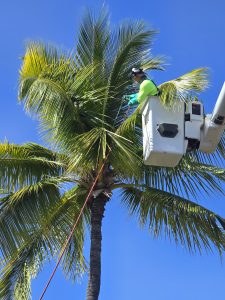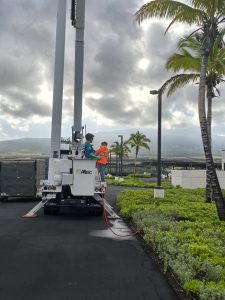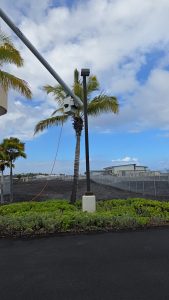HDOA and County of Hawai‘i Continue Coconut Rhinoceros Beetle Treatments at Kona Airport
Posted on May 9, 2025 in MainMay 9, 2025
NR25-11
HONOLULU – The Hawai‘i Department of Agriculture (HDOA), with the assistance of the County of Hawai‘i Public Works Department (COH-PWD), began another round of treatment of palm trees at the Ellison Onizuka Kona International Airport (KOA) on Tuesday, May 6, in an effort to stop the coconut rhinoceros beetle (CRB) from becoming established on Hawai‘i Island. This was a follow-up to treatment conducted last month at the airport.(Link to previous news release: https://dab.hawaii.gov/blog/main/nr25-08-konacrbtreatments/ )
“It really is ‘all hands on deck’ in West Hawai‘i and all our partner agencies are dedicating everything they have to stop the establishment of CRB on Hawai‘i Island,” said Sharon Hurd, chairperson of the Hawai‘i Board of Agriculture. “Mahalo, again, to Mayor Kimo Alameda and his public works crew– their resources and assistance have been phenomenal in this coordinated effort.”
The County of Hawai‘i and HDOA have been working collaboratively since January 2025 after CRB was detected in the Kona area. COH-PWD has been providing the assistance of their boom trucks to treat the tops of palm trees.
The following is a brief timeline of detections and intense treatments around West Hawai‘i:
| October 2023 | A Waikoloa resident found six grubs (larvae) in a decaying palm tree stump. Increased surveillance continued throughout the island and more intensely on the Kona side. |
| April 2024 | The Big Island Invasive Species Committee (BIISC) reported that four adult CRB were found in three traps in the Waikoloa area. |
| September 2024 | HDOA Plant Pest Control (PPC) personnel found a single CRB in a trap during routine monitoring in Waikoloa. |
| January 2025 | The County of Hawai‘i offered its resources and assistance to HDOA, including the use of its 75-foot boom truck to treat the crowns of palm trees. |
| Jan. 14, 2025 | Waikoloa Village – HDOA/COH team treated a total of 38 trees via crown treatments and 24 trees were treated via an injection system which provides systemic protection against CRB. |
| March 3, 2025 | BIISC reported one adult CRB in a detection trap along the boundary of KOA. A day later, BIISC reported that two more adult CRBs were found in traps at the Natural Energy Laboratory of Hawai‘i (NELHA). |
| March 14-19 2025 | KOA – HDOA/COH and KOA airport staff used two boom trucks to treat 123 trees on the airport grounds and injected 12 more trees that were inaccessible to the boom trucks. |
| April 7 & 8, 2025 | NELHA – HDOA/COH crews treated the crowns of 44 trees and injected 14 trees due to the close proximity to water. |
| April 15, 16 & 21, 2025 | Honokōhau Small Boat Harbor and Marina – HDOA/COH crews treated 313 crowns and treated 50+ trees via injection due to the close proximity to water. |
| April 24, 2025 | West Hawai‘i Veteran’s Cemetery – 13 crowns treated. BIISC had reported finding one wing of an adult CRB. Although a full specimen was not found, HDOA treated all palms on the site as a precaution. |
| May 6, 2025 | KOA – HDOA/COH and Kona airport staff treated 86 palms via crown application. |
| May 2025 | Treatment at the Keāhole Ag Park is being scheduled later this month. |
| Ongoing | Surveillance for CRB continues around Hawai‘i Island by HDOA, BIISC, University of Hawai‘i, the County of Hawai‘i and the state Department of Health Vector Control Branch. |
| March 2025 to present | A total of 10 adult CRB have been reported in the areas of Keāhole Ag Park, NELHA, O‘oma, Kohanaiki and KOA. |
Staff from HDOA’s Plant Pest Control Branch and Pesticides Branch applied the treatments, both on the crown of the trees and via injection into the trees when necessary. All palms that were treated were tagged and surrounded with yellow tape to indicate treatment. Coconuts from treated trees should not be consumed. Questions regarding pesticide use may be addressed to HDOA’s Pesticides Branch at 808-973-9402.
Residents on all islands are asked to be vigilant when purchasing mulch, compost and soil products, and to inspect bags for evidence of entry holes. CRB breed in decomposing plant and animal waste. An adult beetle is about 2-inches long, all black and has a single horn on its head. CRB leave distinctive V-shaped cuts and/or scalloped edges in palm leaves and bore holes may be visible in the trunks.
Residents may go to the CRB Response website at: https://www.crbhawaii.org/ to learn more about how to detect the signs of CRB damage and how to identify CRB life stages. Reports of possible CRB infestation may also be made to the state’s toll-free Pest Hotline at 808-643-PEST (7378).
# # #
Link to video by County of Hawai‘i: https://drive.google.com/file/d/1sfY1cZxHJkVQeTkQzs2hPCRmzbO_RX54/view?usp=share_link



